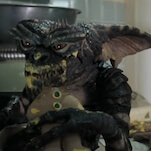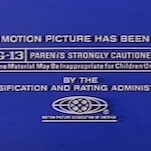Although its 2-D visuals and dialogue-free story wouldn’t immediately suggest it, one of the best things to be said about Mushroom 11 is the way it evokes memories of Portal. There are surface-level similarities—both games center on mad science run amok, and developer Untame has cheerfully cribbed Valve’s “teach, then test” approach to introducing new aspects of the game’s playable world—but the meat of the comparison hides farther down, in the physics-defying underpinnings of both games.
Mushroom 11 is easier to experience than describe—and more fun, too, especially when you get to send the blob racing down and around tunnels or through long narrow passages, as in some of the game’s most memorable moments. It works something like this: The player controls a large green blob, which will always grow to a certain pre-set volume, provided it’s touching something solid. You move the blob by using your mouse to erase portions of its mass, which then regrow on the creature’s opposite side. The growing edge of the blob acts a bit like a liquid and the rest like a weighted solid, which allows the fungal colony to squeeze into the various shapes and configurations demanded by the game’s intricate level designs and use its bulk to push and pull things around. It can also split and regrow from even a single piece of itself, provided the rest of the mass is erased.
From these simple rules, Mushroom 11 builds a series of levels that run the blob through its paces, pushing players to discover everything their bizarre avatar can do. Gaps are cleared, ramps are formed, ceilings are crept across, and weights are delicately manipulated, all through the simple act of erasing the blob and guiding its forward growth. Along the way, the player passes through blighted landscapes and signs of a recent apocalypse, with indirect storytelling—like stumbling across a graveyard just a few feet from a ruined playground—performing the majority of the narrative work.
The puzzle design is Mushroom 11’s biggest draw, though. Most of the challenges involve manipulating the environment (and the blob) to navigate or bypass hazards and pits, lest they destroy the gooey crusader and send it back to the nearest checkpoint. Sometimes that’s done with slow, methodical precision, with the player coaxing the blob around corners or over gaps, delicately grooming it into the proper shape like a bulbous bonsai tree.
Other challenges demand more speed and finesse, though, and it’s during those that Mushroom 11 occasionally stumbles. As enjoyable as the game’s pushing and pruning can be, it works better when it’s allowed a bit of time to be used precisely. Consequently, some of the more fast-paced sections can feel like you’re doing little more than sending a prayer to the virtual-physics gods and hoping for good luck. It doesn’t help that the camera sometimes struggles to keep track of which portion of the blob is the “main” component, meaning you can lose progress when it decides to follow a small falling piece while the bulk of the colony is dissolved off-screen.
But for every one of its hair-pulling moments, the occasional challenges of dexterity that demand a dozen or more attempts to master, Mushroom 11 always has another “aha” moment waiting in the wings. (The generous checkpoints don’t hurt, either.) The game’s boss battles, especially, are a pleasure—with big, bizarre creatures slowly falling to the blob’s environmental tricks and learned techniques—and serve as a welcome reward for surviving a level’s worth of traps.
For all the comparisons to older games like Portal or Braid or even the similarly slime-based World Of Goo, Mushroom 11 is never anything less than its own game, with a unique approach to physics and a clear understanding of all the fun things players can accomplish with it. Its real triumph, though, is in how it coaxes players to discover all of its little tricks and quirks via level and puzzle design that never dips below being consistently, delightfully intelligent. Considering that it’s only the second game from a relatively untested team, it’s a fantastic PC debut, and one that deserves to be mentioned in the same breath as other members of that aforementioned physics puzzler hall of fame.








































